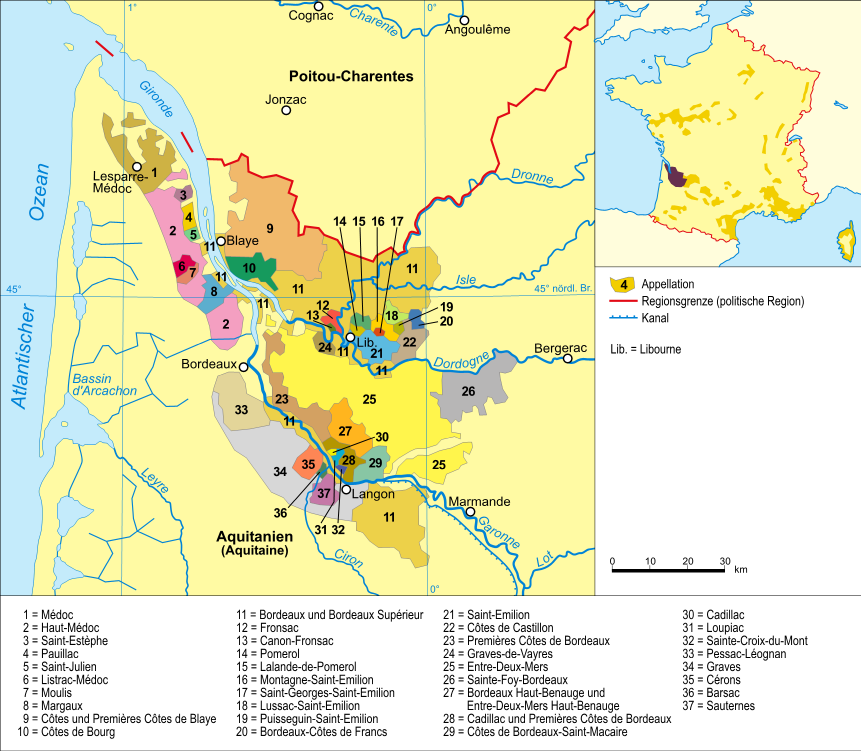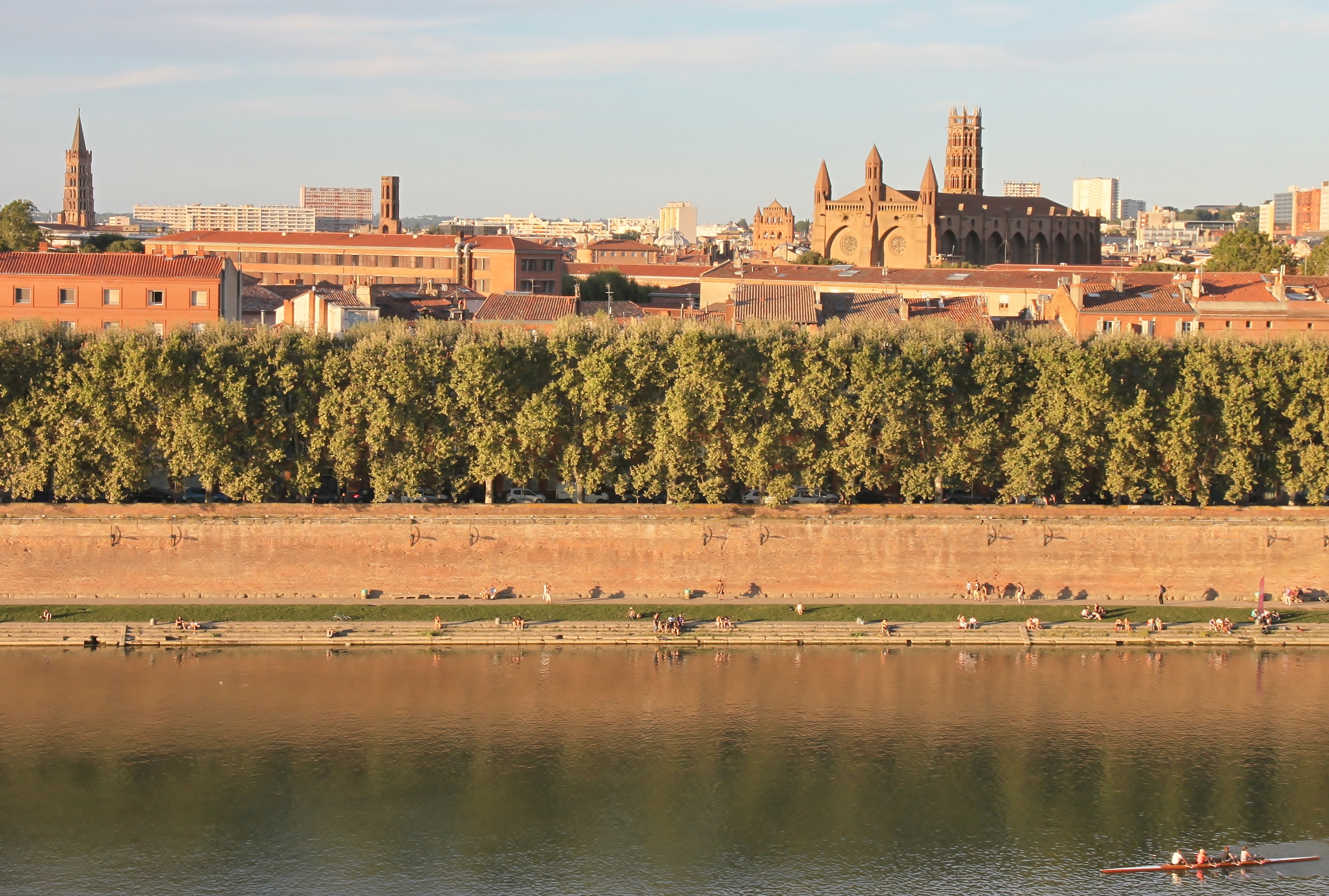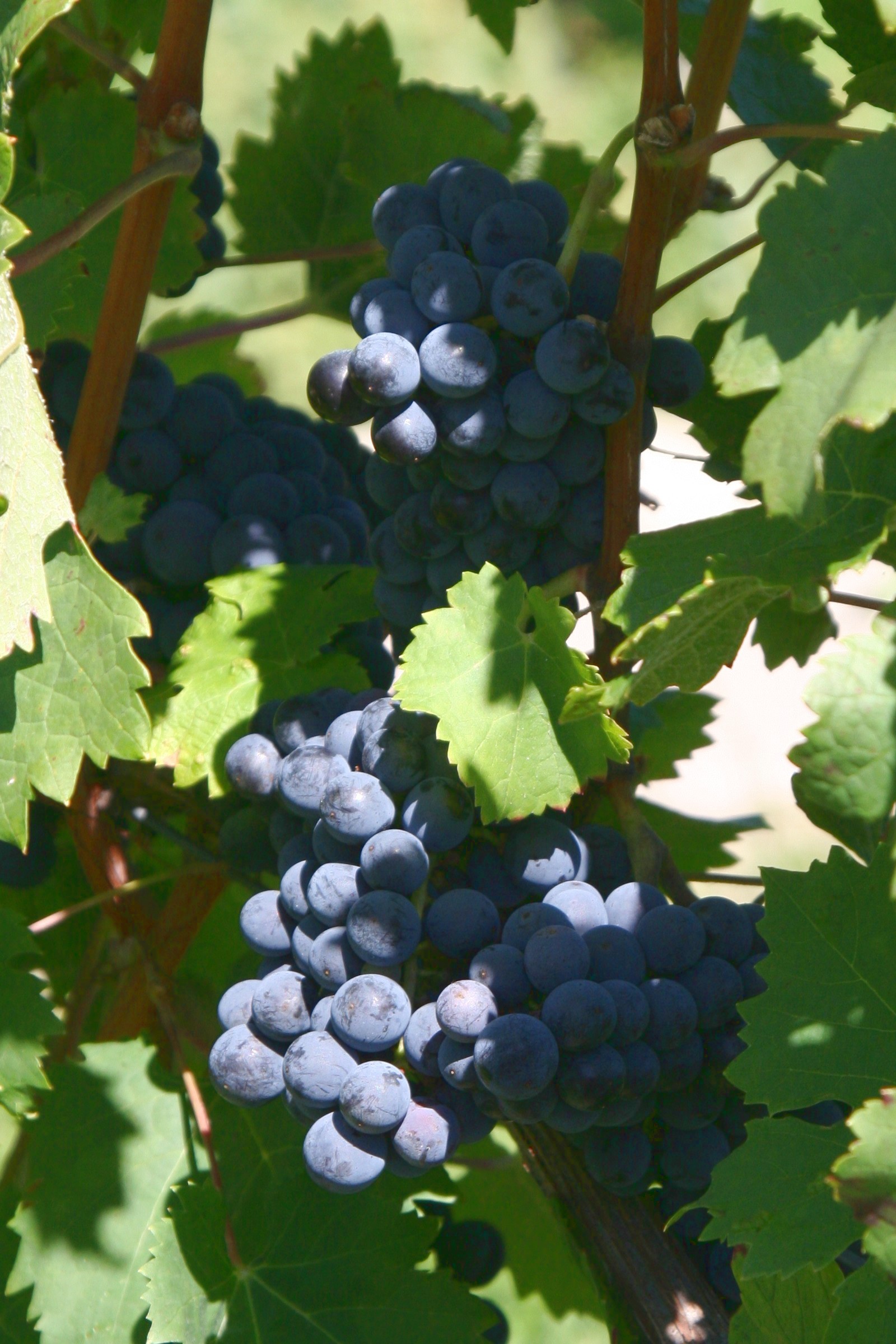|
Lussac-Saint-Émilion AOC
Lussac-Saint-Émilion () is an ''Appellation d'origine contrôlée'' (AOC) for red wine situated in the Bordeaux wine region. The appellation is located on the right bank of the Garonne and Dordogne rivers, about from city of Bordeaux or from the medieval village of Saint-Émilion. It is one of the so-called "Saint-Émilion satellites" situated around the appellation Saint-Émilion AOC itself. Terroir The terroir of Lussac is characterized by the diversity of its soils, distributed between the plateaus, the sides of the hills, and small valleys. To the south-east, the slopes are clayey-limestone, similar in nature to those in the Saint-Emilion appellation. To the west, there is an elevated gravel and sandy-gravel plateau, not very wide, and to the north, cold clayey soil or heavy clay is predominant. To the east, the subsoil consists of limestone beds which made excellent quarries for extracting soft building stone. To the north-west, there are a few stone quarries, as well as fer ... [...More Info...] [...Related Items...] OR: [Wikipedia] [Google] [Baidu] |
Appellation D'origine Contrôlée
In France, the ''appellation d'origine contrôlée'' (, ; abbr. AOC ) is a label that identifies an agricultural product whose stages of production and processing are carried out in a defined geographical area – the ''terroir'' – and using recognized and traditional know-how. The specificity of an AOC product is determined by the combination of a physical and biological environment with established production techniques transmitted within a human community. Together, these give the product its distinctive qualities. The defining technical and geographic factors are set forth in standards for each product, including wines, cheeses and meats. Other countries and the European Union have similar labeling systems. The European Union's protected designation of origin (PDO and PGI) system has harmonized the protection of all geographical indications and their registration. When labelling wine however, producers may still use recognized traditional terms like AOC, and are not requ ... [...More Info...] [...Related Items...] OR: [Wikipedia] [Google] [Baidu] |
Bordeaux Wine
Bordeaux wine (; ) is produced in the Bordeaux region of southwest France, around the city of Bordeaux, on the Garonne River. To the north of the city, the Dordogne River joins the Garonne forming the broad estuary called the Gironde; the Gironde department, with a total vineyard area of 110,800 hectares, is the second largest wine-growing area in France behind the Languedoc-Rousillon. Average vintages produce over 700 million bottles of wine, ranging from large quantities of daily table wine to some of the world's most expensive and prestigious wines. The vast majority of wine produced in Bordeaux is red (sometimes called "claret" in Britain), with sweet white wines (most notably Sauternes), dry whites, and (in much smaller quantities) rosé and sparkling wines ( Crémant de Bordeaux) collectively making up the remainder. Bordeaux wine is made by more than 5,660 producers or ''châteaux''. There are 65 appellations of Bordeaux wine. History Viticulture was introduce ... [...More Info...] [...Related Items...] OR: [Wikipedia] [Google] [Baidu] |
Garonne
The Garonne ( , ; Catalan language, Catalan, Basque language, Basque and , ; or ) is a river that flows in southwest France and northern Spain. It flows from the central Spanish Pyrenees to the Gironde estuary at the French port of Bordeaux – a length of , of which is in Spain (Val d'Aran);Le bassin versant de la Garonne Syndicat Mixte d'Études & d'Aménagement de la Garonne the total length extends to if one includes the Gironde estuary between the river and the sea. Its basin area is , which increases to if the Dordogne (river), Dordogne River, which flows from the east and joins the Garonne at Bec d'Ambès to form the Gironde estuary, is included. Umayyad and Duchy of Aquitaine , Aquitanian forces fought the Battle of the River Garonne in 732 beside the river near present-day ... [...More Info...] [...Related Items...] OR: [Wikipedia] [Google] [Baidu] |
Dordogne
Dordogne ( , or ; ; ) is a large rural departments of France, department in south west France, with its Prefectures in France, prefecture in Périgueux. Located in the Nouvelle-Aquitaine region roughly half-way between the Loire Valley and the Pyrenees, it is named after the river Dordogne (river), Dordogne, which runs through it. It corresponds roughly to the ancient county of Périgord. In January 2023, Dordogne had a population of 412,807. History The county of Périgord dates back to when the area was inhabited by ancient celtic Gauls, Gaulish tribes. It was originally home to four tribes, and since "four tribes" in the Gaulish language is "Petrocore", the area eventually became known as the county of Le Périgord. Its inhabitants became known as the Périgordins (or Périgourdins), and there are four Périgords in the Dordogne. * Périgord Vert (Green Périgord), with its main town of Nontron, consists of verdant valleys in a region crossed by many rivers and streams ... [...More Info...] [...Related Items...] OR: [Wikipedia] [Google] [Baidu] |
Bordeaux
Bordeaux ( ; ; Gascon language, Gascon ; ) is a city on the river Garonne in the Gironde Departments of France, department, southwestern France. A port city, it is the capital of the Nouvelle-Aquitaine region, as well as the Prefectures in France, prefecture of the Gironde department. Its inhabitants are called "''Bordelais'' (masculine) or "''Bordelaises'' (feminine). The term "Bordelais" may also refer to the city and its surrounding region. The city of Bordeaux proper had a population of 259,809 in 2020 within its small municipal territory of , but together with its suburbs and exurbs the Bordeaux Functional area (France), metropolitan area had a population of 1,376,375 that same year (Jan. 2020 census), the sixth-most populated in France after Paris, Lyon, Marseille, Lille, and Toulouse. Bordeaux and 27 suburban municipalities form the Bordeaux Métropole, Bordeaux Metropolis, an Indirect election, indirectly elected Métropole, metropolitan authority now in charge of wi ... [...More Info...] [...Related Items...] OR: [Wikipedia] [Google] [Baidu] |
Saint-Émilion
Saint-Émilion (; Gascon dialect, Gascon: ''Sent Milion'') is a Communes of France, commune in the Gironde department in Nouvelle-Aquitaine in Southwestern France. In the heart of the country of Libournais (the area around Libourne), in a region of wine hills, Saint-Émilion is a medieval city located at the crossroads of Bordeaux, Saintonge (region), Saintonge and Périgord. The town and Saint-Émilion AOC, surrounding vineyards was made a UNESCO World Heritage Site in 1999, owing to its long, living history of wine-making, Romanesque architecture, Romanesque churches and ruins stretching all along steep and narrow streets. History Saint-Émilion's history goes back at least 35,000 years, to the Upper Paleolithic. An ''oppidum'' was built on the hill overlooking the present-day city in Gauls, Gaulish times, before the region was annexed by Augustus in 27 BC. The Ancient Rome, Romans planted vineyards in what was to become Saint-Émilion as early as the 2nd century AD. In the 4t ... [...More Info...] [...Related Items...] OR: [Wikipedia] [Google] [Baidu] |
Saint-Émilion AOC
Saint-Émilion () is an ''appellation d'origine contrôlée'' (AOC) for red wine in the Bordeaux wine region of France, where it is situated in the Libourne subregion on the right bank of the Dordogne (river), Dordogne. As a cultural landscape demonstrating a long, living history of wine-making (dating from Roman times), Saint-Émilion was registered as a UNESCO World Heritage Site in 1999. Its represent 67.5% of the total area of wine-producing communes (Saint-Émilion, Saint-Christophe-des-Bardes, Saint-Hippolyte, Gironde, Saint-Hippolyte, Saint-Étienne-de-Lisse, Saint-Laurent-des-Combes, Gironde, Saint-Laurent-des-Combes, Saint-Pey-d'Armens, Saint-Pey-d’Armens, Saint-Sulpice-de-Faleyrens, Vignonet, and a part of the Libourne commune) and 6% of the total Bordeaux vineyard. The wines of Saint-Émilion are typically blended from different grape varieties, the three main ones being Merlot, Cabernet Franc and Cabernet Sauvignon. Classification Since 1955, there has been ... [...More Info...] [...Related Items...] OR: [Wikipedia] [Google] [Baidu] |
Terroir
(; ; from ''terre'', ) is a French language, French term used to describe the environmental factors that affect a crop's phenotype, including unique environment contexts, farming practices and a crop's specific growth habitat. Collectively, these contextual characteristics are said to have a character; ''terroir'' also refers to this character. Some artisanal crops and foods for which ''terroir'' may apply include wine, cheese, Single-origin coffee, coffee, single malt whisky, onions, and tea. ''Terroir'' is the basis of the French wine ''appellation d'origine contrôlée'' (AOC) system, which is a model for wine appellation and regulation in France and around the world. The AOC system presumes that the land from which the grapes are grown imparts a unique quality that is specific to that growing site (the plants' habitat). The extent of terroir's significance is debated in the wine industry. Origins Over the centuries, French winemakers developed the concept of terroir by ob ... [...More Info...] [...Related Items...] OR: [Wikipedia] [Google] [Baidu] |
Cabernet Franc
Cabernet Franc is one of the major black grape varieties worldwide. It is principally grown for blending with Cabernet Sauvignon and Merlot in the Bordeaux (wine), Bordeaux style, but can also be vinified alone, as in the Loire (wine), Loire's Chinon wine, Chinon. In addition to being used in blends and produced as a varietal in Canada (wine), Canada, Lake Erie AVA, Lake Erie AVA in Pennsylvania, and across the United States (wine), United States and Argentina, it is sometimes made into ice wine in those regions. Cabernet Franc is lighter than Cabernet Sauvignon, making a bright pale red wine that contributes finesse and lends a Black pepper, peppery perfume to blends with more robust grapes. Depending on the growing region and style of wine, additional Aromas (wine), aromas can include tobacco, raspberry, bell pepper, Blackcurrant, cassis, and Viola (plant), violets. Records of Cabernet Franc in Bordeaux go back to the end of the 18th century, although it was planted in Loire ... [...More Info...] [...Related Items...] OR: [Wikipedia] [Google] [Baidu] |
Cabernet Sauvignon
Cabernet Sauvignon () is one of the world's most widely recognized red wine grape varieties. It is grown in nearly every major wine producing country among a diverse spectrum of climates from Australia and British Columbia, Canada to Lebanon's Beqaa Valley. This grape variety appeared in France in the 17th century as a result of natural crossbreeding. Its popularity is often attributed to its ease of cultivation—the grapes have thick skins and the vines are hardy and naturally low yielding, budding late to avoid frost and resistant to viticulture hazards. The classic profile of Cabernet Sauvignon tends to be full-bodied wines with high tannins and noticeable acidity that contributes to the wine's aging potential. In cool areas, it has flavors of blackcurrant and green pepper; in warmer places, it may taste like black cherry and olive; in very hot climates, it can have a jammy flavor. History and origins For many years, the origin of Cabernet Sauvignon was not cl ... [...More Info...] [...Related Items...] OR: [Wikipedia] [Google] [Baidu] |
Malbec
Malbec () is a purple grape variety used in making red wine. The grapes tend to have an inky dark color and robust tannins, and are known as one of the six grapes allowed in the blend of red Bordeaux wine. In France, plantations of Malbec are now found primarily in Cahors in South West France, though the grape is grown worldwide. It is also available as an Argentine varietal. The grape became less popular in Bordeaux after 1956 when frost killed off 75% of the crop. Despite Cahors being hit by the same frost, which devastated the vineyards, Malbec was replanted and continued to be popular in that area. Winemakers in the region frequently mixed Malbec with Merlot and Tannat to make dark, full-bodied wines, but have ventured into 100% Malbec varietal wines more recently.J. Robinson ''Vines, Grapes & Wines'' pg 198 & 204 Mitchell Beazley 1986 A popular but unconfirmed theory claims that Malbec is named after a Hungarian peasant who first spread the grape variety throughou ... [...More Info...] [...Related Items...] OR: [Wikipedia] [Google] [Baidu] |
Merlot
Merlot ( ) is a dark-blue-colored wine grape variety that is used as both a blending grape and for varietal wines. The name ''Merlot'' is thought to be a diminutive of , the French name for the blackbird, probably a reference to the color of the grape. Its softness and "fleshiness", combined with its earlier ripening, make Merlot a popular grape for blending with the sterner, later-ripening Cabernet Sauvignon, which tends to be higher in tannin. Along with Cabernet Sauvignon, Cabernet Franc, Malbec, and Petit Verdot, Merlot is one of the primary grapes used in Bordeaux wine, and it is the most widely planted grape in the Bordeaux wine regions. Merlot is also one of the most popular red wine varietals in many markets. This flexibility has helped to make it one of the world's most planted grape varieties. As of 2004, Merlot was estimated to be the third most grown variety at globally.J. Robinson (ed) ''The Oxford Companion to Wine'' Third Edition, Oxford University P ... [...More Info...] [...Related Items...] OR: [Wikipedia] [Google] [Baidu] |





